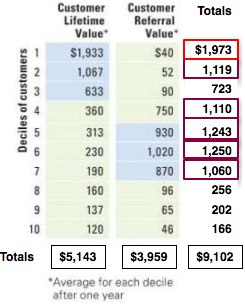As some readers may know, I've both read and commented on Malcolm Gladwell's Tipping Point, and found it an interesting book to think about the nature of communities and how certain individuals or groups of them are more influential in passing on ideas than others. That said, while I believe that such "influencers" exist, also from personal experience, I know fairly little about the science of it.
Similarly, Duncan Watts a research scientist at Columbia, working at Yahoo, questioned that principle, asserting that news travels fast, through whatever type of individual. I have no doubt that Yahoo has amassed vast amount of data on what source of del.icio.us bookmarks receive the most clicks, etc., and that the nature of the internet allows even the lowest of the lowest content-provider or -mediator (e.g. yours truly) to lead people to news.
A recent HBR-article gave me some insight into the complexities for companies to measure the value of such referential actions, something they call Customer Referral Value (CRV). It is calculated by estimating the number of successful referrals made by a customer, but differentiating between new customers that came because of his/her referral, and those that would have come anyway. It's a fairly complex formula and requires some extensive market-research, but you can find a good overview in the HBR-article.
This is opposed to a customer's lifetime value (CLV), the traditional way of measuring the value of customers, which looks at the amount that the customer's purchases contribute to the companies operating margin, less the marketing costs to him or her, and projected over a certain period of time.
Using this methodology, the authors of the article measured both the CLV and the CRV of 9,900 customers at a telecom-company and came up with following results:
I added the totals myself, because I thought those would also be interesting. What you can see here is that those with the highest CLV also presented the highest total value to the business, though CRV added considerable value also. What's also interesting is how these are distributed. The high value shoppers added relatively little in referential value, and only in the medium-levels do we see a high amount of CRV.
Through three one-year marketing-campaigns aimed at the high shoppers with low referential value, the medium CLVs with high CRVs, and the low of both, the company tried to stimulate the customers with lower values in either segment to do more, either by spending more or by referring more. The result was a 15.4 return on investment on the marketing-campaign, meaning that for each dollar spent on marketing to customers, $15.4 was gained in revenue.
Clearly, I could say more about how the authors went about it to make these kinds of gains in both CLV and CRV, however that's why this nice article was written about it and I encourage people to check it out if they're interested.
Are there implications for the Gladwell vs. Watts fight? In my opinion, either could be right. What Gladwell has merely done is open our eyes a little towards this whole viral marketing-thing, though certainly some companies were already busy with it. And what Watts is pointing out is that there is great value in building on top of existing networks, something I'm sure the telecom-company benefited from also. The greater lesson here is to look beyond the CLV of a customer, though that already brings a high value to companies, and focus on methods of stimulating word of mouth in innovative ways. How that is achieved depends on the type of business and the networks that it can use to communicate with its customers. Certainly, Milner cheese, which I wrote about a few weeks ago, offers one possible answer. Update: and so does the recent marketing-move by Etsy on Twitter.
This article is mirror-posted on Tech IT Easy.
Similarly, Duncan Watts a research scientist at Columbia, working at Yahoo, questioned that principle, asserting that news travels fast, through whatever type of individual. I have no doubt that Yahoo has amassed vast amount of data on what source of del.icio.us bookmarks receive the most clicks, etc., and that the nature of the internet allows even the lowest of the lowest content-provider or -mediator (e.g. yours truly) to lead people to news.
A recent HBR-article gave me some insight into the complexities for companies to measure the value of such referential actions, something they call Customer Referral Value (CRV). It is calculated by estimating the number of successful referrals made by a customer, but differentiating between new customers that came because of his/her referral, and those that would have come anyway. It's a fairly complex formula and requires some extensive market-research, but you can find a good overview in the HBR-article.
This is opposed to a customer's lifetime value (CLV), the traditional way of measuring the value of customers, which looks at the amount that the customer's purchases contribute to the companies operating margin, less the marketing costs to him or her, and projected over a certain period of time.
Using this methodology, the authors of the article measured both the CLV and the CRV of 9,900 customers at a telecom-company and came up with following results:

I added the totals myself, because I thought those would also be interesting. What you can see here is that those with the highest CLV also presented the highest total value to the business, though CRV added considerable value also. What's also interesting is how these are distributed. The high value shoppers added relatively little in referential value, and only in the medium-levels do we see a high amount of CRV.
Through three one-year marketing-campaigns aimed at the high shoppers with low referential value, the medium CLVs with high CRVs, and the low of both, the company tried to stimulate the customers with lower values in either segment to do more, either by spending more or by referring more. The result was a 15.4 return on investment on the marketing-campaign, meaning that for each dollar spent on marketing to customers, $15.4 was gained in revenue.
Clearly, I could say more about how the authors went about it to make these kinds of gains in both CLV and CRV, however that's why this nice article was written about it and I encourage people to check it out if they're interested.
Are there implications for the Gladwell vs. Watts fight? In my opinion, either could be right. What Gladwell has merely done is open our eyes a little towards this whole viral marketing-thing, though certainly some companies were already busy with it. And what Watts is pointing out is that there is great value in building on top of existing networks, something I'm sure the telecom-company benefited from also. The greater lesson here is to look beyond the CLV of a customer, though that already brings a high value to companies, and focus on methods of stimulating word of mouth in innovative ways. How that is achieved depends on the type of business and the networks that it can use to communicate with its customers. Certainly, Milner cheese, which I wrote about a few weeks ago, offers one possible answer. Update: and so does the recent marketing-move by Etsy on Twitter.
This article is mirror-posted on Tech IT Easy.
 The
The 

